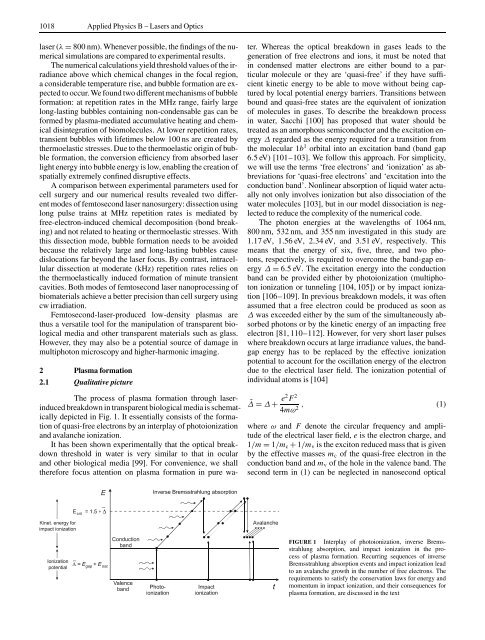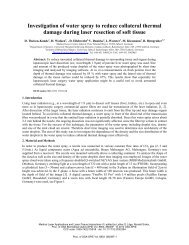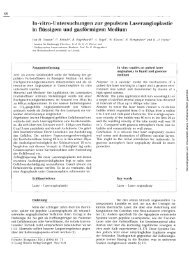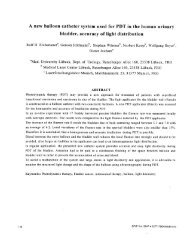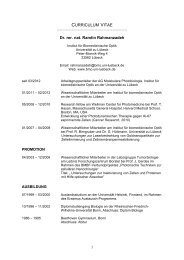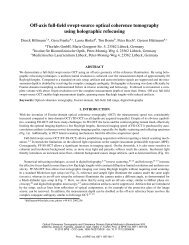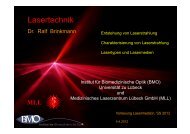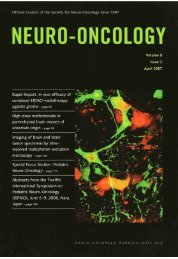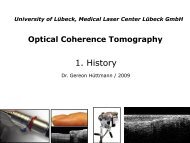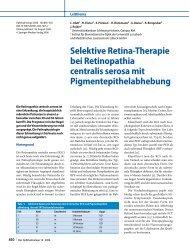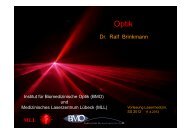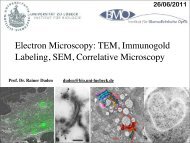Invited p aper Mechanisms of femtosecond laser nanosurgery of ...
Invited p aper Mechanisms of femtosecond laser nanosurgery of ...
Invited p aper Mechanisms of femtosecond laser nanosurgery of ...
You also want an ePaper? Increase the reach of your titles
YUMPU automatically turns print PDFs into web optimized ePapers that Google loves.
1018 Applied Physics B – Lasers and Optics<strong>laser</strong> (λ = 800 nm). Whenever possible, the findings <strong>of</strong> the numericalsimulations are compared to experimental results.The numerical calculations yield threshold values <strong>of</strong> the irradianceabove which chemical changes in the focal region,a considerable temperature rise, and bubble formation are expectedto occur. We found two different mechanisms <strong>of</strong> bubbleformation: at repetition rates in the MHz range, fairly largelong-lasting bubbles containing non-condensable gas can beformed by plasma-mediated accumulative heating and chemicaldisintegration <strong>of</strong> biomolecules. At lower repetition rates,transient bubbles with lifetimes below 100 ns are created bythermoelastic stresses. Due to the thermoelastic origin <strong>of</strong> bubbleformation, the conversion efficiency from absorbed <strong>laser</strong>light energy into bubble energy is low, enabling the creation <strong>of</strong>spatially extremely confined disruptive effects.A comparison between experimental parameters used forcell surgery and our numerical results revealed two differentmodes <strong>of</strong> <strong>femtosecond</strong> <strong>laser</strong> <strong>nanosurgery</strong>: dissection usinglong pulse trains at MHz repetition rates is mediated byfree-electron-induced chemical decomposition (bond breaking)and not related to heating or thermoelastic stresses. Withthis dissection mode, bubble formation needs to be avoidedbecause the relatively large and long-lasting bubbles causedislocations far beyond the <strong>laser</strong> focus. By contrast, intracellulardissection at moderate (kHz) repetition rates relies onthe thermoelastically induced formation <strong>of</strong> minute transientcavities. Both modes <strong>of</strong> <strong>femtosecond</strong> <strong>laser</strong> nanoprocessing <strong>of</strong>biomaterials achieve a better precision than cell surgery usingcw irradiation.Femtosecond-<strong>laser</strong>-produced low-density plasmas arethus a versatile tool for the manipulation <strong>of</strong> transparent biologicalmedia and other transparent materials such as glass.However, they may also be a potential source <strong>of</strong> damage inmultiphoton microscopy and higher-harmonic imaging.2 Plasma formation2.1 Qualitative pictureter. Whereas the optical breakdown in gases leads to thegeneration <strong>of</strong> free electrons and ions, it must be noted thatin condensed matter electrons are either bound to a particularmolecule or they are ‘quasi-free’ if they have sufficientkinetic energy to be able to move without being capturedby local potential energy barriers. Transitions betweenbound and quasi-free states are the equivalent <strong>of</strong> ionization<strong>of</strong> molecules in gases. To describe the breakdown processin water, Sacchi [100] has proposed that water should betreated as an amorphous semiconductor and the excitation energy∆ regarded as the energy required for a transition fromthe molecular 1b 1 orbital into an excitation band (band gap6.5eV) [101–103]. We follow this approach. For simplicity,we will use the terms ‘free electrons’ and ‘ionization’ as abbreviationsfor ‘quasi-free electrons’ and ‘excitation into theconduction band’. Nonlinear absorption <strong>of</strong> liquid water actuallynot only involves ionization but also dissociation <strong>of</strong> thewater molecules [103], but in our model dissociation is neglectedto reduce the complexity <strong>of</strong> the numerical code.The photon energies at the wavelengths <strong>of</strong> 1064 nm,800 nm, 532 nm, and355 nm investigated in this study are1.17 eV, 1.56 eV, 2.34 eV, and 3.51 eV, respectively. Thismeans that the energy <strong>of</strong> six, five, three, and two photons,respectively, is required to overcome the band-gap energy∆ = 6.5eV. The excitation energy into the conductionband can be provided either by photoionization (multiphotonionization or tunneling [104, 105]) or by impact ionization[106–109]. In previous breakdown models, it was <strong>of</strong>tenassumed that a free electron could be produced as soon as∆ was exceeded either by the sum <strong>of</strong> the simultaneously absorbedphotons or by the kinetic energy <strong>of</strong> an impacting freeelectron [81, 110–112]. However, for very short <strong>laser</strong> pulseswhere breakdown occurs at large irradiance values, the bandgapenergy has to be replaced by the effective ionizationpotential to account for the oscillation energy <strong>of</strong> the electrondue to the electrical <strong>laser</strong> field. The ionization potential <strong>of</strong>individual atoms is [104]The process <strong>of</strong> plasma formation through <strong>laser</strong>inducedbreakdown in transparent biological media is schematicallydepicted in Fig. 1. It essentially consists <strong>of</strong> the formation<strong>of</strong> quasi-free electrons by an interplay <strong>of</strong> photoionizationand avalanche ionization.It has been shown experimentally that the optical breakdownthreshold in water is very similar to that in ocularand other biological media [99]. For convenience, we shalltherefore focus attention on plasma formation in pure wa-˜∆ = ∆ + e2 F 24mω 2 , (1)where ω and F denote the circular frequency and amplitude<strong>of</strong> the electrical <strong>laser</strong> field, e is the electron charge, and1/m = 1/m c + 1/m v is the exciton reduced mass that is givenbytheeffectivemassesm c <strong>of</strong> the quasi-free electron in theconduction band and m v <strong>of</strong> the hole in the valence band. Thesecond term in (1) can be neglected in nanosecond opticalFIGURE 1 Interplay <strong>of</strong> photoionization, inverse Bremsstrahlungabsorption, and impact ionization in the process<strong>of</strong> plasma formation. Recurring sequences <strong>of</strong> inverseBremsstrahlung absorption events and impact ionization leadto an avalanche growth in the number <strong>of</strong> free electrons. Therequirements to satisfy the conservation laws for energy andmomentum in impact ionization, and their consequences forplasma formation, are discussed in the text


